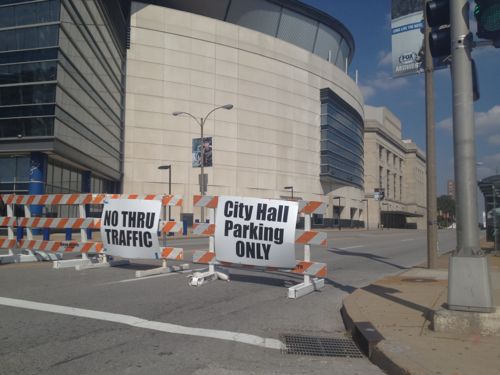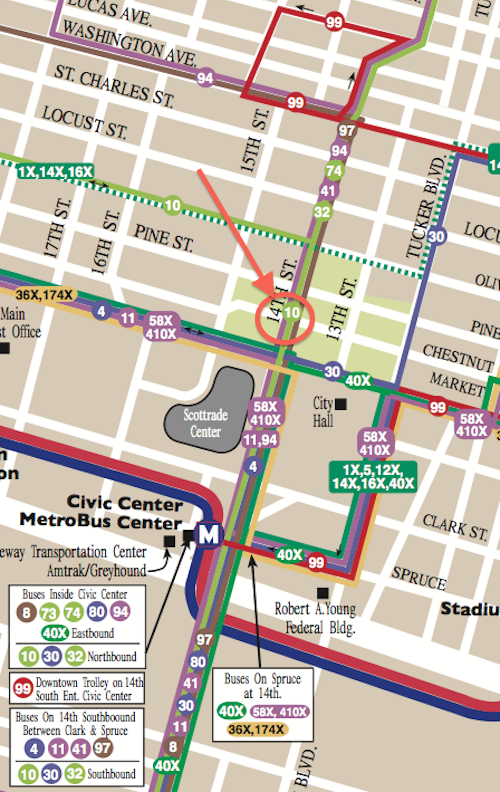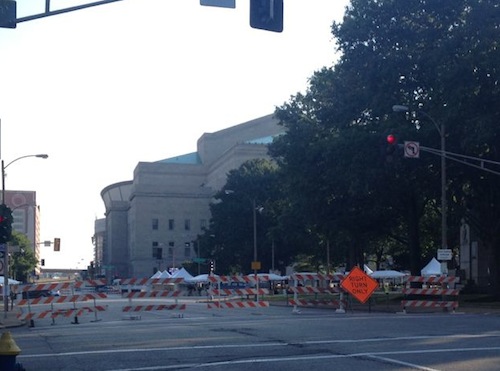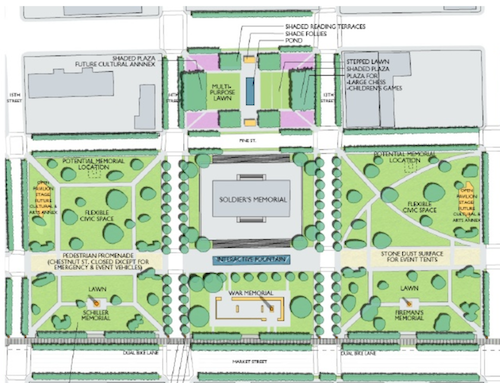14th Street Conflict: Transit vs Events
14th Street is a very popular north-south street through downtown St. Louis. Unfortunately, it’s too popular. Nearly every MetroBus that comes into downtown uses 14th just as nearly every event shuts down at least one intersection along 14th, usually at Chestnut, requiring many buses to reroute.



It seems like twice per month there’s a festival, concert, run, walk, bike ride, parade, or something that totally screws up the bus routes and schedules. All because the events shut down the primary route used by the buses. Because we’ve messed up our street grid for years by removing streets and making others one-way 14th St is the only choice for these bus routes. The reroutes that go into place are time consuming, making that route late everywhere it travels.
The solution is to remove the conflict, not close 14th St. How you ask? Not possible right now, but perhaps once the area is redesigned.

From the Master Plan:
The Civic Room will create a large unified space well-suited for civic events, markets, festivals and concerts. In order to achieve this, it is anticipated that Chestnut Street would be closed incrementally over time, beginning with temporary closures for festivals, and ultimately considered for permanent or seasonal closure. though still allowing emergency and service vehicles access. Chestnut Street should be still be hard surfaced with a paving different than surrounding areas, to accommodate tents and other services necessary for festivals. Locations for performance stages and cultural or art annexes should be provided to further define the civic character of the space and create attractions to activate the mall.
This is good, just the wrong location. Rather than Tucker (12th) to 15th I think it needs to be 14th to 17th or 18th. 18th St is a busy street but it doesn’t have any bus routes, close it for an event to combine with Aloe Plaza to 20th. But from 15th to 20th the space is narrow, from Market to Chestnut only.
If the St. Louis Streetcar gets funded and built, 14th St will need to stay open so I hope someone creative can find a way to hold events here while still allowing all transit vehicles continuous access to 14th St.
Transit is important but so are events. One shouldn’t be compromised by the other. Tomorrow’s post will be about design issues with the current area around the Soldier’s Memorial along with some possible solutions.
— Steve Patterson
You say “If the St. Louis Streetcar gets funded and built, 14th St will need to stay open”. I say that, as in every other city, the streetcar will be disrupted by both special events and emergency situations. Putting a bus on rails does not grant it immunity from the rules that govern every other form of traffic, it just makes it harder for it to deal with any inevitable disruptions!
The bigger question is if and why every major special event needs to be downtown, in the first place? Why not spread both the pain and the joy across the city? SLU / Grand Center offers opportunities, as do Forest Park, Tower Grove Park and Carondolet Park. Fairgrounds Park and O’Fallon Park would be great venues IF people would get past their fears about going north of Delmar. And when it comes to parades and other linear events, they will always disrupt public transit – the only way to avoid disruptions is to put them where people don’t want to be!
Agreed.
First, it’s kind of insulting/disrespectful that most of the City’s major festivals are held at the Soldier’s Memorial. Booze, barbecue and cover bands are not a proper honor to the U.S. military past and present.
Second, this results in every single festival looking basically the same. The same events management company, the same footprint, the same vendors, the same (or similar) music acts, etc. Every event is homogenized to the point of apathy. I fully expect now that the Pride Festival has moved downtown, it’ll become somewhat indistinguishable as well.
If you get your precious downtown streetcar, Steve, I’d prefer the City take back some of this unnecessarily large “Civic Room” by converting one of the seven (!) blocks — preferably the most northerly one — for actual, active use as the drop-off point for the streetcar. Imagine the streetcar cutting into that area and picking up/dropping off riders in a well-maintained, well-used space, directly between the library and the Memorial.
Is it really wise to close Chestnut? I like the re-envisioning of the park across from the Public LIbrary. Everything else about that plan looks like another grandiose mistake in the making. Except during big events, Market to Olive is doomed to be a vast dead zone. Good, I guess, that the homeless people will still have somewhere to hang out. (And maybe they’ll even bring back the benches they used to sit on.) But who else is going to go down there and why? The Soldiers Memorial is already a lonely, mostly forgotten place.
And why should downtown be turned into a monumental playground for weekenders. Whatever happened to the idea of a 24/7 zone?
I avoid that whole area because of the homeless people, and that’s also the reason I’ve never been to either the Soldier’s Memorial or the library (I’ve lived at 11th and Lucas for 4 years). I visit the library on Euclid in the CWE occasionally, trudging up from the Metrolink station there. As for the transit issues, I plan my schedule to avoid traveling on days that streets are closed. I realize, however, that people who have to get to work on those days do not have that luxury.
boo-fucking-hoo
The central problem is that the design of St. Louis is poor and continues to be poor. Here is one of many examples from cities all over the world I could cite. It is a square at Place du Palais Royal, Paris, France, the subway is at the bottom of the square, buses run along the side of the square and so on, it is really rather simple for everyone except the Neanderthal city planners in St. Louis.
And here is a nice view from Paris Daily Photo.
http://www.parisdailyphoto.com/2013/10/the-largest-street-decoupage-in-world.html
The public transit and the size of the square are very apparent in this photo.
Type in Place du Palais Royal, Paris, France into Google maps for another view. I like to go to street view and literally walk around.
https://maps.google.com/maps?q=Place+du+Palais+Royal,+Paris,+France&hl
Design is a problem. The “central problem,” though, is the humongous
concentration of social services downtown, the relative lack of residents, and
the declining number of jobs. There is this myth running rampant that downtown
can design its way out of trouble. (Re-do the arch grounds, re-do the Gateway
mall, re-do the redo….). All of this based on the vision of downtown as a
“destination” for suburbanites and tourists looking for a place to play. They
should take the money they’re spending on redesigns and either subsidize new
residents or, better yet, do something real about the homeless epidemic.
i like how the homeless hating trolls are so far behind the times that they just discovered this blog, hilarious.
Who is it you think “hates” the homeless? I want something done: like taking
the gazzilion dollars we’re planning to spend on the arch grounds remake and use
it for affordable housing, better services, etc. Are you referring to the guy
above who avoids the western part of downtown because of the homeless
population? What’s the point of demonizing someone who has, at least, chosen to
live downtown? Save the resentment, bro, for a more worthy target.
And who’s the troll here? I don’t post a lot, but I’ve been visiting this
site literally since it started. I’m not a regular poster, but there are reasons
for that.
I am referring to him and you. The Arch Grounds remake is funded by a sales tax increase that was passed by the voters. Put a sales tax to help the homeless on the ballot, see how that works out.
It probably isn’t that bad over there, and I should probably force myself to visit both the library and Soldier’s Memorial. People who don’t live in the city can be even more paranoid. A suburbanite person I worked with felt the need to chauffeur his adult daughter down to the Old Post Office at like 7 PM in the evening for a class or event she needed to attend, purely out of concern for her safety. However, that person is a St. Louis native who has worked in the city since the 70’s and has seen the city at its worst. I’ve only been here four years but used to live in urban Milwaukee, not quite as bad, but similar in many ways.
It isn’t bad at all, the Soldier’s Memorial is a spectacular structure with great exhibits. The renovated library is a major resource.
The post is about the integration of transit with public space, a design problem. I guess you have not been to or lived in well designed cities (not many in US). The fact is a well designed city would in fact attract residents downtown. But you want to subsidize new residents instead of creating a desirable environment that attracts them by choice??? Yeah I’m sure subsidized residents will be committed to the downtown environment.
As far as homeless go, it is a different issue entirely. I wouldn’t call it an epidemic, society is poorly managed with the wealthiest pulling trillions of dollars out of the economy to gamble on wall street, the wealthy play with money and create nothing of value. There are few decent paying entry level jobs, most have been shipped overseas. The result–a whole economic underclass with no where to go, no chance to escape. So any policy changes to help poverty and homelessness need to start with the bloated financial sector, taxing the hell out of their meaningless days and reinvesting the money in America.
But homelessness has nothing to do with staging events and how routing mass transit is impacted.
Do you ever come downtown? Or to the city?
Wow! How much self-righteousness can we crowd into one little posting? We’re about to spend millions and millions of dollars redesigning elements of downtown. When businesses flee, when potential residents refuse to consider living there, I don’t hear them complaining that there aren’t enough public events or vast empty spaces. I do hear a lot about social issues. I agree that more subsidies for more residents would be misguided, but I think it would accomplish more than this new turn to goofy monumentalism. Yes, I live in the city. Yes, I come downtown a lot. Perhaps you could find some other way to delegitimize my posting.
You seem to exhibit the usual suburban myths about the city, my asking if you lived or visited the city was a simple question, you are the one blowing everything out of proportion. And not enough public events or vast empty spaces, what does that have to do with anything?
I guess you must hang around people that complain a lot about the social environment and issues. The fact is the discussion I see here on Steve’s blog and around town is about building a viable city.
I get it, you prefer not to invest in improvements to the city. Steve’s post was about the integration of civic space and transit, that is what I originally commented on, if you would rather rant about the homeless or whatever, that’s up to you.
Here is a link to Senate Square in Helsinki. It is a large square, capable of handling typical events that St. Louis holds. It is fronted by streetcars and buses.
http://goo.gl/L51StW
In fact one of the ironies in St. Louis and for this civic room is when it is used the mass transit is pushed away, when in fact you would think there would be a greater need for transit to help contribute to the success of the event.
There are a few other points, public space such as Senate Square needs to be planned for over a period of time, something that St. Louis planners do not seem to be able to do. It requires the integration of transit and the surrounding streets that are full of shops and apartments to feed the square. The numerous shops also help manage overflow from the square. The St. Louis civic room has none of those characteristics except large civic buildings all around.
There is a large civic building on Senate Square, the Helsinki Cathedral. The Helsinki Cathedral directly connects with the square with a large staircase and is not separated by a road. this is often the case in other public spaces like this throughout the world.
In a way the St. Louis civic room has an uphill battle for success, there is limited transit access, absolutely no street level shopping anywhere near, very little residential close to this site, large civic structures that surround the space and actually increase separation and further contribute to the lack of walkability of the area.
Basically this civic room goes against almost all characteristics for successful public space that have been developed for centuries.
What this points to is a rethinking of the whole downtown.
Does Helsinki have other urban venues and/or suburban options that would compete with this, or is this pretty much the only option? The challenge I see in the St. Louis region is that we have multiple options and none is used every day. The nearest we may come is Busch Stadium, and that’s not truly a public space. The great European public squares “work” because they’re used every day, not just 20-some days every year (and being left to the homeless and the pigeons the rest of the time). We can only “design” our way out of this if we design for real uses, not by designing for fantasies or partial uses.
JZ, yes Helsinki uses variations of public space and squares frequently. Not too distant from Senate Square is the central train station and plaza (designed by Elliel Saarinen, father of Eero). That plaza too is fronted by shops and apartments. You can find public space like this all over Helsinki. There was one square I came across that was built in the sixties or seventies in the suburbs located at what would be the equivalent of a metrolink stop. So they continue to using similar planning methods to date.
In fact rather than emptying onto parking lots or wastelands like most metrolink stations in St. Louis, major stops in Helsinki always empty onto some type of appealing human orientated environment. (It is not hard to guess which system encourages transit use)
The key in all of this so we are not designing for fantasies is to provide for all the elements that make a public space successful. As I pointed out above the civic room in St. Louis has almost none of those elements and is an isolated public space that lacks a surrounding walkable environment.
In the case of Senate Square and the Central Station Plaza they are directly connected to the larger walkable city and in fact one can easily walk between the two plazas. (roughly 6 blocks apart) In addition there is another smaller plaza one block away from Senate Square along the harbor that is used for farmer markets and adjacent to that is a kauppahalli or market building with numerous stalls similar to Soulard although it is all indoors due to the long winters. These kauppahalli are often coupled with public space, for example Hakaniemen Kauppahalli is on another square in Helsinki.
What this all amounts to is that planners in Helsinki use all of the tools and resources available to design successful public space. In St. Louis that doesn’t happen.
It is important to note that Helsinki metro area is about the same population as St. Louis.